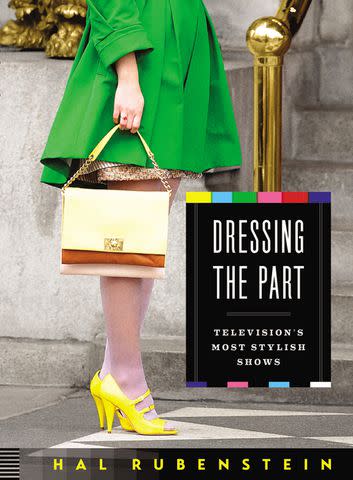Style Expert Hal Rubenstein Praises ‘Gorgeous Tableau’ of “Friends” and the Importance of TV Fashion (Exclusive)
The founding ‘InStyle’ editor dishes on the iconic outfits in ‘The Golden Girls,’ ‘Sex and the City’ and more in his new book, ‘Dressing the Part’

Harper, Taghi Naderzad
Hal Rubenstein knows a thing or two about style. As a founding editor and former fashion director of InStyle Magazine, as well as being a designer himself, he’s seen it all throughout his career. In his new book, however, Rubenstein tackles a topic that he says he hasn’t seen touched before: television costume design.
“TV’s everybody’s in-home stylist,” Rubenstein tells PEOPLE. “It’s so influential over what hangs in our closet and what we perceive as beauty and style and fashion.”
Dressing the Part: Television’s Most Stylish Shows, out now from Harper, is a comprehensive look at some of television’s most iconic fashion choices. From The Mary Tyler Moore Show to RuPaul’s Drag Race, Rubenstein delves into decades of on-screen style, as well as their impact on how we understand the world around us.

Harper
'Dressing the Part' by Hal RubensteinTelevision helps us to perceive certain moments in time. Shows like Dynasty, Rubenstein says, “defined the way everybody perceived glamor in the eighties,” while others, like Gossip Girl, held so much influence that brands like Chanel and Versace sent clothes unsolicited to the set every week, in hopes that the show’s young stars would wear them. Rubenstein also credits Sex and the City as not only helping to reshape the perception of women in their thirties or forties — “they’re still sexy, they’re still powerful" — but also to reshape the public’s view of 90s New York City.
“Sex and the City said, ‘No, this [city] is Disneyland for adults. It's all bright and shiny and it's full of fun and cosmos and sex and cupcakes from Magnolia Bakery and all the Manolos you want. It made brands like Manolo, like the Fendi Baguette, household names. Even if people [watching] couldn't afford a Fendi Baguette, they all knew what it was,” Rubenstein says.
Related: Carrie Bradshaw's Iconic Fashion and the Trends 'Sex and the City' Helped Create

Everett Collection
The cast of 'Sex and the City'Other television shows utilized fashion to make a statement. Rubenstein recalls when Lucille Ball wore maternity clothes on I Love Lucy, calling the fact that she embraced her pregnancy, and continued with her slapstick comedy, “revolutionary.” Other shows, like The Golden Girls, used costumes to showcase a particular point in life.
Related: Happy Anniversary, Golden Girls! A Guide to Living the 'Golden' Life
“I think the show was, in some ways, a very important barometer and very important encouragement for women who became older,” Rubenstein says. He also tells of the costume decisions that Bea Arthur, who played Dorothy, made, as she was “very self-conscious” about her looks.

ABC Photo Archives / Getty
The cast of 'The Golden Girls'“She had in her contract that she could rehearse in bare feet because she was so much taller and bigger than the rest [of the cast],” Rubenstein says. “She always wore flats. She never wore heels.”
Rubenstein is quick to point out the hard work that costume designers do to make a show’s fashion work. Friends, he notes, was an interesting challenge for costume designer Debra McGuire, who was tasked with making sure the wardrobes of six very different characters didn’t clash on-screen.
“You have Chandler in looser suits. You have Joey in the leather jacket. Monica's always in brighter colors. Phoebe's always in earth tones. [Rachel is] probably the most stylish because she would work at Bloomingdale's and she would work at Ralph, and she's the one who came from money,” Rubenstein says. “Each one of them had their own lane, and yet when they got together…it made a gorgeous tableau.”

Alamy
The cast of 'Friends'Reality and variety television also embraces clothing in an important way. Rubenstein says that RuPaul’s Drag Race is "the most influential fashion TV show in America,” and that the Kardashians have the power to show “different perceptions of beauty" on the runway.
Another influential show for him was Soul Train, which Rubenstein watched on Saturday mornings growing up. He writes of the “spectacular” clothes broadcast into homes every weekend: the pinwheel gowns and pleated pants, the sharkskin suits and silver capes.
“That show taught us how to look, how to dress and how to dance,” Rubenstein says.

Soul Train/Getty
'Soul Train' dancersNever miss a story — sign up for PEOPLE's free daily newsletter to stay up-to-date on the best of what PEOPLE has to offer, from juicy celebrity news to compelling human interest stories.
Dressing the Part, Rubenstein hopes, will remind readers just how much television has shaped the fashion in their own lives.
“We all know how powerful TV is in taking up our time when we binge-watch Bridgerton or shows like that,” he says. "But it's also how much we owe to these people in terms of shaping how we create our own personalities, how we create our wardrobes. How important it is to present yourself to the world in a way that they can understand who you are, that your clothes really do matter.”
Dressing the Part is now available.
For more People news, make sure to sign up for our newsletter!
Read the original article on People.


